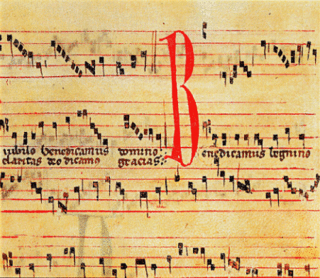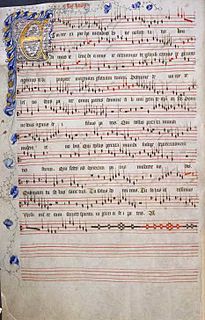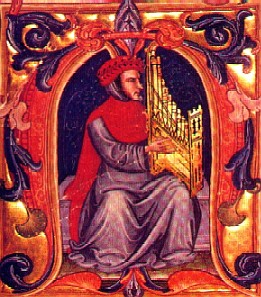 W
WArs cantus mensurabilis is a music theory treatise from the mid-13th century, c. 1250–1280 written by German music theorist Franco of Cologne The treatise was written shortly after De Mensurabili Musica, a treatise by Johannes de Garlandia, which summarised a set of six rhythmic modes in use at the time. In music written in rhythmic modes, the duration of a note could be determined only in context. Ars cantus mensurabilis was the first treatise to suggest that individual notes could have their own durations independent of context. This new rhythmic system was the foundation for mensural notation system and the ars nova style.
 W
WThe Bamberg Codex is a manuscript containing two treatises on music theory and a large body of 13th-century French polyphony.
 W
WAdd MS 29987 is a medieval Tuscan musical manuscript dating from the late fourteenth or early fifteenth century, held in the British Library in London. It contains a number of polyphonic Italian Trecento madrigals, ballate, sacred mass movements, and motets, and 15 untexted monophonic instrumental dances, which are among the earliest purely instrumental pieces in the Western musical tradition. The manuscript apparently belonged to the de' Medici family in the fifteenth century, and by 1670 was in the possession of Carlo di Tommaso Strozzi; it was in the British Museum from 1876, where it was catalogued as item 29987 of the Additional manuscripts series. It is now in the British Library.
 W
WThe Manuscrit du Roi or Chansonnier du Roi is a prominent songbook compiled towards the middle of the thirteenth century, probably between 1255 and 1260 and a major testimony of European medieval music. It is currently French manuscript no.844 of the Bibliothèque nationale de France. It is known by various sigla, depending on which of its contents are the focus of study: it is troubadour manuscript W, trouvère manuscript M, and motet manuscript R. It was first published by French musicologist Pierre Aubry in 1907.
 W
WThe Chantilly Codex is a manuscript of medieval music containing pieces from the style known as the Ars subtilior. It is held in the museum at the Château de Chantilly in Chantilly, Oise.
 W
WThe Jenaer Liederhandschrift is a 14th-century manuscript containing lyrics and melodies to songs in Middle High German. The majority of the lyrics belong to the genre of Spruchdichtung and, with 91 melodies, the manuscript is the single most important source for the music of this genre.
 W
WThe Codex Las Huelgas (E-BUlh) is a music manuscript or codex from c. 1300 which originated in and has remained in the Cistercian convent of Santa María la Real de Las Huelgas in Burgos, in northern Spain. The convent was a wealthy one which had connections with the royal family of Castile.
 W
WThe Laudario di Cortona is a musical codex from the second half of the 13th Century containing a collection of laude.
 W
WThe Llibre Vermell de Montserrat is a manuscript collection of devotional texts containing, amongst others, some late medieval songs. The 14th-century manuscript was compiled in and is still located at the monastery of Montserrat outside Barcelona in Catalonia (Spain).
 W
WThe Magnus Liber or Magnus liber organi, written in Latin, was a repertory of medieval music known as organum. The book was in use by the Notre-Dame school composers working in Paris around the end of the 12th and beginning of the 13th centuries. It is known from references to a "magnum volumen" by Johannes de Garlandia and to a "Magnus liber organi de graduali et antiphonario pro servitio divino" by the English music theorist known simply as Anonymous IV. Today it is known only from later manuscripts containing compositions named in Anonymous IV's description.
 W
WThe Montpellier Codex is an important source of 13th-century French polyphony. The Codex contains 336 polyphonic works probably composed c. 1250–1300, and was likely compiled c. 1300. It is believed to originate from Paris. It was discovered by musicologist Edmond de Coussemaker in c. 1852.
 W
WMusica enchiriadis is an anonymous musical treatise of the 9th century. It is the first surviving attempt to set up a system of rules for polyphony in western art music. The treatise was once attributed to Hucbald, but this is no longer accepted. Some historians once attributed it to Odo of Cluny (879-942). It has also been attributed to Abbot Hoger.
 W
WThe Old Hall Manuscript is the largest, most complete, and most significant source of English sacred music of the late 14th and early 15th centuries, and as such represents the best source for late Medieval English music. The manuscript somehow survived the Reformation, and formerly belonged to St. Edmund's College, a Roman Catholic school located at Old Hall Green in Hertfordshire. It was sold to the British Library after an auction at Sotheby's in 1973.
 W
WPluteo 29.1, also known as Pluteus 29.1, or simply the Florence Manuscript, is an illuminated manuscript in the Laurentian Library of Florence.
 W
WRegimen Animarum is a Latin codex that was written in 1343 for the Archbishop of Canterbury. It contains the Office of the Feast of Corpus Christi.
 W
WThe Répertoire International des Sources Musicales is an international non-profit organization, founded in Paris in 1952, with the aim of comprehensively documenting extant historical sources of music all over the world. It is the largest organization of its kind and the only entity operating globally to document written musical sources. RISM is one of the four bibliographic projects sponsored by the International Musicological Society and the International Association of Music Libraries, Archives and Documentation Centres, the others being Répertoire International de Littérature Musicale, Répertoire international d'iconographie musicale, and Répertoire international de la presse musicale.
 W
WThe Robertsbridge Codex (1360) is a music manuscript of the 14th century. It contains the earliest surviving music written specifically for keyboard.
 W
WThe Roman de Fauvel is a 14th-century French allegorical verse romance of satirical bent, generally attributed to Gervais du Bus, a clerk at the French royal chancery. The original narrative of 3,280 octosyllabics is divided into two books, dated to 1310 and 1314 respectively, during the reigns of Philip IV and Louis X. In 1316–7 Chaillou de Pesstain produced a greatly expanded version.
 W
WThe Selden Carol Book is a medieval carol manuscript held by the Bodleian Library in Oxford. Along with the Trinity Carol Roll, with which it shares five contemporaneous carols and texts, it is one of the main sources for 15th century English carols, and like the Trinity Roll contains the music as the well as the texts. The inclusion of Deo Gracias Anglia referencing Henry V's victory at Agincourt in 1415 gives an indication of the date of composition of the carols.
 W
WThe Speciálník Codex is a 15th-century speciálník originating from a monastery in the region of Praha (Prague). Its eclectic mix of Medieval and Renaissance a cappella sacred music is matched only by its brilliant juxtapositions of well-known and obscure pieces and composers. Containing works for two, three, and four voices, the Codex is one of the oldest surviving collections of Czech Renaissance polyphony, and originated in the Utraquist protestant congregations of around 1500. The manuscript is currently in the Hradec Králové Museum, which acquired it from a Prague antique dealer in 1901.
 W
WThe Squarcialupi Codex is an illuminated manuscript compiled in Florence in the early 15th century. It is the single largest primary source of music of the 14th-century Italian Trecento.
 W
WThe Trinity Carol Roll is a 15th-century manuscript of thirteen English carols held by the Wren Library at Trinity College, Cambridge. It is the earliest surviving example of polyphonic music written in English. Compiled after 1415, it contains the earliest of two manuscript sources for the Agincourt Carol which tells of Henry V's victory at the Battle of Agincourt, as well as several early Christmas carols. The majority of texts are in Middle English with some of the carols alternating between Latin and Middle English, a common form for carols of the period known as macaronic.
 W
WThe Winchester Troper includes perhaps the oldest large collections of two-part music in Europe, along with the Chartres Manuscript, which is approximately contemporaneous or a little later.